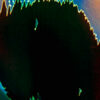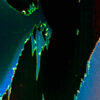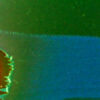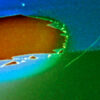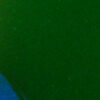On a sign, there is a cartoon gull with a red X superimposed, asking people not to feed the gulls. It is ignored: the first stale crust of bread hits the water. In seconds the air fills with the cackle of gulls and the laughter of children. I watch a family of five pass an Iceland carrier bag around, taking turns at throwing scraps into the shallow river. Fifty or so herring gulls and lesser black-backed gulls flash white and grey wings, while their silky brown juveniles, a month old at most, wobble past. The young don’t enter the melee. The adults do, turning on a wingtip, hurtling waterwards, deftly snatching scraps of bread before exiting at speed, pursued by scavengers.
The next day, I find a feather on the path along the river. A better birder than I am would be able to tell you the species it came from by the top eighth of it. They would have committed to memory the shape of the white marking and the wedge of black that isolates it at the tip, and would know the significance of the gap of white again below the black before it descends into the signature grey of a gull’s wing. I rely on that grey, sootied and slatey, to tell me this belongs to one of the lesser black-backed gulls that nest in the rain-slicked chimney pots of my town, Dumfries.
When I had gone to the river, the sky had been blue, though grey clouds were building. Then suddenly not: streaks of rain thrum at the roof and window panes, a thousand impatient fingertips drum on the asphalt. My daughter sleeps through it, her soft wispy hair curling against the cot sheet. I step outside, just to confirm: very wet.
The shower passes. Sun. The wet road reflects like old silver, and the remaining water in the air splits the light into an arc of vivid colours, somehow out of keeping with this sombre late summer day. A younger juvenile gull, dark feathers with pale notches blending against the dazzle of the road, pecks at something unspeakable washed in by the rain. Its head is still downy, waiting for the feathers to grow.
–
There is a simple principle here. All life requires water. We are dependent, beholden to the stuff on a bodily level. Without water, the cells in your body – and in every bit of non-human life on earth – would not work. They would not move or hold their structure or be able to use oxygen. As Alok Jha writes, ‘to say that water is integral to life understates the case’.
When we look for life existing on other planets we search, probe and model for the presence of water. We don’t know how water got to be here, on our planet – much is locked up in the secrets of the Big Bang – but we know how it is made, the simple, magical bond of two atoms of hydrogen to one atom of oxygen.
Two more simple principles. All water comes from the environment. Water that passes into the body of a living thing gets absorbed and transformed into new tissues. The particular location that each drop of water comes from gets encoded in the body of every living thing like a chemical serial number. The metabolic system does change things but the old adage generally holds: you are what you eat and drink.
The rain; where the bird is and where it has been; whether its meals are carpark offal or past-its-best bread or a wriggling eel-like lamprey: all of that ends up in their feathers. The trick is how to read it.
–
Ruedi Nager is a gull man for impressively contrarian reasons. We are standing outside the chemistry laboratory in East Kilbride, eight-miles south of Glasgow; the sun has slipped free from the concrete clouds behind my head and Ruedi squints at me while choosing his words.
‘It’s always interesting to work with gulls. Because everybody else hates them’.
I don’t disagree. Ruedi, a senior lecturer at Glasgow University and editor of the journal Ibis, is one of Britain’s pre-eminent ornithologists, obsessed with both what we can learn about birds and what we can learn from them. He continues.
‘There’s that annoying bit where they are called seagulls. Which gets rid of the distinction that they are different species, with different natural histories and ecology. You can’t really throw them all in one pot.’
We have begun with distinctions and specificities because we are here to talk about stable isotope analysis. It is a geologist’s tool that ornithologists have recently picked up, with staggering results. It enables them to look beneath the surface of the feather and see ever-greater levels of distinction. Where I see species, they see individuals. I see an age, they see histories. I see a gull in a car park and they can see the place where it metabolised water into feathers, food into energy, oxygen into blood.
Ruedi leads me into the lab. Inside, machines the size of small fridges hum, wires and cables leading out of them and looping back in. Lights blink. Lab technicians walk past, some in white coats, some in latex gloves. A computer screen is stared at. What they do in here, put plainly, is feed samples of an object (say, a feather) through these machines until a series of lines and numbers are produced as a graph on a computer screen.
What that graph says is as foreign to me as a language I don’t speak and have never heard spoken. Coleridge used to attend science lecturers to enlarge his pool of metaphors, and although science looks less romantic now, with glass flasks and tubes relegated to a corner of the lab, what this graph means is changing the way I think. This is sub-particular chemistry, analysing the world at a level even smaller than the smallest particle.
‘Stable isotopes have been used quite well,’ says Jason Newton, drily. He is head of the Stable Isotope Ecology Laboratory. We stand in the middle of his lab, the low ceiling amplifying the dull hum of machinery while he casts his mind back. ‘There was a good paper from America. A nice little citizen science project with school kids. They got them to raise a whole load of monarch caterpillars using only local rainwater – because it can be quite different to tap water – so the caterpillars grew having only experienced the water from that location. Nature happens…’ he waves his hand, ‘They turned into butterflies and when they died their wings were sampled.’
This is where it gets less citizen.
‘And now they’ve created an isoscape of butterfly wing hydrogen isotopes.’
There are times around scientists that I feel like Byron. The Byron, that is, who wrote that Coleridge should ‘explain his explanation’.
Rona McGill, a Glasgow University lecturer, helps. She’s worked long enough with Jason to pick up his sentences and run with them.
‘An isoscape is a map with different isotope values. You see broad big patterns with precipitation as it moves inland, with altitude in mountain ranges and really strong differences between the equator and the poles.’
More explanation might be needed.
Everything on earth is made of at least one of 118 elements if you break it down small enough. Each of these elements can be seen as being its own species. But in this analogy there are subspecies too; distinct variations, the thing but different to the-thing-as-normally-found. These are the isotopes: an element, built differently. Hydrogen is made of one proton and one electron. Deuterium – an isotope of hydrogen – is one proton, one electron and one neutron. Tritium, another isotope of hydrogen, has a second neutron.
There are two types of isotope: the stable and the radioactive. Stable isotopes, like deuterium, hang about not doing a great deal, simply being present in the environment. Radioactive isotopes – such as tritium, or the carbon-14 used in carbon-dating the age of objects – decay. In natural history, interest usually lies with the objects that do things, but in this lab they are interested in the isotopes that do nothing, just persist, stable in the permanent flux of the environment. They form a fixed ratio. One deuterium atom can be found to every 6,500 atoms of hydrogen in seawater.
Deuterium’s extra neutron weighs it down, a third heavier than normal hydrogen. When it bonds with oxygen it makes heavy water. And then it enters the water cycle. When clouds drift inland it is the heavy water that falls as rain first. The further into a continent you get, the less deuterium you find. This makes deuterium a great tracer, a metric, something to measure and compare by. It is possible, then, by analysing the ratio of deuterium to hydrogen in an object, to place that object on that map; to locate where it was formed in the landscape of hydrogen.
–
The example Jason and Rona have to hand is not avian, but the principle holds. They have a bundle of wildebeest tail hair, black and wiry as a horse’s, taken from a study site in the Tanzanian Serengeti.
Jason says, ‘That’s one of the things I find surprising about stable isotopes, particularly with hydrogen. You think about the process from start to finish. The water begins in the ocean, evaporates into the clouds, changes composition and drops as rain. It goes into the grass that is eaten by a wildebeest, and the water they drink. And the wildebeest then makes protein, the keratin that’s in their tail hair, which actually, at the end of the day, still reflects the cloud’s rainwater after all those steps.’
Hair is like a basic version of feathers, a keratin growth on the outside of the animal. Feathers facilitate flight and that’s about the only difference. But hair, as Rona picks up, ‘Is a really good example to explain to the public. Because you can imagine, as it grows, that it reflects the food that the animal was eating. But it is also inert, so it only reflects the diet when it was being grown.’
Inert is a key factor here. Stable isotopes only work as a metric because the isotopes remain at constant ratios to each other, so the part of the animal sampled only works if it doesn’t change either, or if it only changes at a known rate. Take blood. Split it up by spinning it, quickly. Centrifugal force will separate the red blood cells from the watery plasma. The plasma will show the animal’s diet from the past week, maybe less. The red blood cells carry the isotopic signatures of the past month. You can plot change from the differences between the two. But the unchanging signatures of hair and feathers that are grown and persist are easier to work with (and less invasive) than taking blood from a wild animal.
The deuterium isotope is particularly effective with birds. It is summer as I write this, moult season, and feathers are being shed and regrown in their millions. A few weeks ago I found, for the first time, the electric blue covert feather from a jay’s wing, gleaming jewel-like from the grass beside a woodland path. Yesterday, a colleague came to work with a fistful of barn owl flight feathers found on a nearby hill. If we were operating a study and had the money to run the analyses (‘about £20 if we get the instruments going’), we would grind up ten of the hair-like filaments known as barbs from these feathers into a powder, fold them into a flake of silver and drop them into a mass spectrometer. Something that is easier to write than perform, I note, as Rona’s tweezers send a silver flake scattering across the lab bench. We agree that it is one of those tasks – like unlocking a door, or parallel parking – that is impossible with an audience watching.
A mass spectrometer is an exceedingly complicated and niche bit of kit, disguised as an ordinary medium-sized grey box. Spectrometer means a machine that measures things that exist on a spectrum. The differences it can tell are incredibly minute, too small for us to perceive, such as the weight of atoms. The mass spectrometer has a heater in it, able to reach 1150 degrees centigrade, hot enough for the sample to turn into gas. The feather-powder in silver is vapourised into hydrogen, oxygen, carbon and other gaseous elements. Bombarding it with electrons ionises the gas, in other words electrically-charging the particles. These are then fired towards a magnet. The magnetic field deflects the ionised isotopes into different directions depending on their weight, separating out the heavier deuterium from the lighter hydrogen, and from the other chemical elements and isotopes present. Separated they can now be measured. I had visualised this as the beginning of a chemical game of pool, where the yellow balls would head one way and the red balls another after the white ball breaks them. But Rona, who is now flicking through a giant wadge of A4 sheets to show me diagrams of what is happening inside, tells me it is even more controlled than that: it is like a beam of white light, she says, passing through a prism and parting into its constituent colours.
And the end result, for my jay, is that it would probably tell me the covert feather was grown in the forest where I found it. My colleague’s barn owl – a young bird – is likely to have not travelled far enough for its isotopes to be distinguishable from where it was found. But sometimes, such as for Danish ornithologist Tony Fox, you can hit the jackpot. In a paper for British Birds, he details the way that in 2005 he was able to use the body of a Baikal teal, an elaborately plumaged Asian duck species, to prove something suspected but never confirmed. The Baikal teal had been shot by a hunter in Denmark. Using the contrast in isotopes from its old, worn feathers and its freshly grown feathers, Fox was able to prove that the bird had grown its old feathers in the deuterium-poor environment of continental Siberia and its new feathers in the deuterium-rich environment of western Europe. It was the first time ornithologists had concrete proof that a wild Baikal teal could get lost on migration and end up in Europe, not only 90 degrees in the wrong direction from where it should have ended up, but thriving (until it met the hunter’s rifle). Previously it was thought that these birds had escaped from zoos and other collections of ornamental wildfowl. Stable isotopes are changing what we know birds can do.
–
There are things we learn directly from birds. And then there are things that birds can show us indirectly.
Off the coast of Brazil, a boat towing longlines brings in its catch of sharks. What the fishermen are about to do is illegal, but it is also unpoliced and highly profitable and – on a pitching deck, riding the Atlantic swell – not unskilled. The sharp blade in their hands traces the outline of the shark’s limbs. It is the cut, the way that blade slips between the stiff cartilage of the fin and thick muscle of its body, that breaks the law. The fin’s destination is not known precisely – knowledge can be a dangerous thing in criminal wildlife trade – but it will be somewhere in Asia, where it forms the essential ingredient in a gourmand’s shark-fin soup. The destination of the rest of the body, the telltale evidence, is swiftly overboard, into the churn of the Falkland and Brazilian currents.
Seabirds scavenge. But they all do it differently, they all have different methods of feeding and preferred food items. Except here. A study Rona worked with found overlaps in the isotopes of Brazilian seabirds. Their diets, and thus their blood, had all become dominated by the discarded corpses of sharks. The birds had, in Ruedi’s phrase, ‘become unintentional detectives’. Unintentional is a good word here. The power of isotopes is that the chemical record they reveal is impartial. The birds have no intent to reveal illegal fishing activity off the coast of Brazil. They just do, their isotopes telling the story of crimes that would otherwise be invisible.
The isotopic evidence of birds eating sharks also highlights another issue: longline fishing, where baited fishing hooks are spaced out on vast lines, is a risky business, though not illegal. Longlines catch all sorts of animals besides the target species of fish, including dolphins, turtles and birds. Birds that attend to the back of a longline fishing boat are likely to die, impaled by the hooks they try to scavenge the bait from and drowning in the wake of the boat. For those that get hauled in alive, some fishermen have taken to cutting the bills off caught birds, fatally maiming them before being left to die at sea, instead of safely removing the hook from the bird. The Albatross Task Force, a partnership between the RSPB and BirdLife International, estimates 100,000 albatrosses die every year due to longline fishing.
Isotope research can show dietary information on a broader scale too. It can distinguish between land and sea-based diets. Among my local lesser black-backed gulls, it could distinguish those who prefer handouts of Hovis to hassling fish as the tide sweeps up the river. It has, in fact, been used to show that not all gulls are the voracious generalists, the rubbish-bins-on-wings of popular stereotype, but that sometimes a preference for bread over fish (or vice versa) is a hardwired specialism for individuals within the same species. Two individuals of the same species will often look identical: the differences between them hidden by appearance. As with the Baikal teal in Denmark, stable isotopes are offering a precise view on the innate messiness of the world. It suggests to me that maybe we have been thinking about species wrongly: that we need to think of species as being formed of individuals rather than one homogenous flock. And sometimes those individuals get lost, sometimes they turn to stale bread and stolen chips. Each of these birds tells us something about the world if we appreciate them as an individual.
Science is unravelling the secrets locked in feathers. It has found a way to read the chemical environment, a story burrowed deep in all of our bodies. When nature writers talk airily about birds telling us about the world we live in, science proves the ways this is not just a metaphor or literary conceit. The isotopes of bird feathers literally embody the world they – we – live in, a knowledge held tissue-deep in their flesh, protein-deep in the keratin of their feathers, in the plasma and red cells of their blood.
It occurs to me that as a non-scientist I work on the anecdotal plane. I ask Jason and Rona a fluffy question about whether isotopes have changed their view of nature, and they say it gives them new research questions and motivations for analysis. Thoughts and feelings suggest to me that gulls are, as Tim Dee puts it ‘the spirit of a place’. Dee thinks it’s why people hate them. Walking along the river, birding and finding feathers, watching the birds that others hate and the way they exploit the town and river for food and rest: I draw my connections from that. It is Jason, Rona and Ruedi who add the gravity of data here, as their work reading the chemical riddles of feathers continues. Ecology is the study of the effects of and the affected by, the dialogue between each living thing. Stable isotope ecology is finding new connections in that web, in the same way that a feather, too, is nothing more than an arrangement of keratin, of horizontal barbs and vertical barbules that fit together like Velcro, individually catching the air, that when stitched into a wing of connections, keeps the bird aloft.
I think back to the feather I found along the river. I knew it belonged to a lesser black-backed gull and from its shape that it is a primary feather from the left wing. I knew it was moulted, because I found it while pushing my daughter’s pram through the park, lying dirty, bent and broken on the tarmac path. Its white stem turned translucent at its bottom. The white marking at its tip was abraded, the barbs splitting, the connections unzipped. Its outline was ragged.
I kept it. It looked tired, like I do: worn down by a summer of raising young, while the gull will be metabolising food into a replacement grown somewhere between the park, the river, the high street and the sky. I look at it differently now. I see the town tied up tightly inside the feather. East Kilbride sweating shopping centres, high rises, and Ballardian surface; the stale bread, chimneypots and rain-washed Tarmac of Dumfries: it’s all there in the feather’s isotopes.
And I am reminded of Tim Dee’s book of gulls, Landfill, in which he responds to Keats’ Lamia by asking, ‘If you could unweave a rainbow, mightn’t it appear even more magnificent… more loveable?’ More enlightening too, I think, but more loveable for sure to know that so much of what we hold dear – the places we go, the food we eat – walks with us, carried indelibly in the chemistry of our body tissue.
Photograph courtesy of the author


